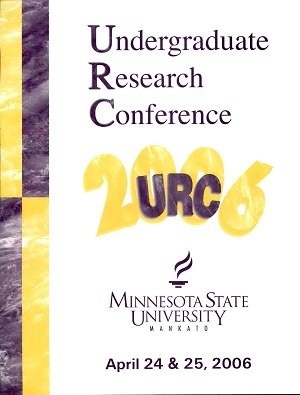Kromoscopic Instrument Development and Detection of Oxidation Damaged LDL and DNA
Location
CSU North Ballroom
Start Date
25-4-2006 10:00 AM
End Date
25-4-2006 12:00 PM
Student's Major
Chemistry and Geology
Student's College
Science, Engineering and Technology
Mentor's Name
Daniel Swart
Mentor's Department
Chemistry and Geology
Mentor's College
Science, Engineering and Technology
Description
This experiment was designed to investigate the utility of the Kromoscopic™ technique in quantifying species such as oxidized LDL (ox-LDL) in human urine. One source of bio-oxidation stems from respirated oxygen being partially reduced to form superoxide, a highly reactive oxygen free radical known to cause damage to both LDL and DNA. Previous studies have used this oxidation product of LDL as a metric for total oxidation occurring in the body.
While similar to spectroscopic techniques, which measure the entire spectrum diffusively, Kromoscopy(tm) uses a set of four spectrally overlapping "sensors", each consisting of a broad filter monitored by a detector. This concept is based on the model of human color perception. Because overtone absorptions are spread throughout the NIR region, initial filter selections are spread evenly over the NIR from 700 to 1200 nm. This overlapping characteristic generates the techniques' selectivity. Each "sensor" must monitor a region which is sufficiently overlapped so that the system can detect small absorption changes due to broad, weak overtones, while still monitoring a discrete zone. Also, the filters must be of sufficient transmittance to provide a high signal to noise ratio.
In order to explore the feasibility of quantifying ox-LDL in urine with this technique, the instrumental design must first be validated through measurements of a well-studied matrix/analyte combination. Initial characterization of the instrument design was carried out utilizing an in-vitro aqueous urea/glucose model. Upon validation, the instrument will be utilized in the measurement of the more complex and novel in-vitro urine/ox-LDL system.
Kromoscopic Instrument Development and Detection of Oxidation Damaged LDL and DNA
CSU North Ballroom
This experiment was designed to investigate the utility of the Kromoscopic™ technique in quantifying species such as oxidized LDL (ox-LDL) in human urine. One source of bio-oxidation stems from respirated oxygen being partially reduced to form superoxide, a highly reactive oxygen free radical known to cause damage to both LDL and DNA. Previous studies have used this oxidation product of LDL as a metric for total oxidation occurring in the body.
While similar to spectroscopic techniques, which measure the entire spectrum diffusively, Kromoscopy(tm) uses a set of four spectrally overlapping "sensors", each consisting of a broad filter monitored by a detector. This concept is based on the model of human color perception. Because overtone absorptions are spread throughout the NIR region, initial filter selections are spread evenly over the NIR from 700 to 1200 nm. This overlapping characteristic generates the techniques' selectivity. Each "sensor" must monitor a region which is sufficiently overlapped so that the system can detect small absorption changes due to broad, weak overtones, while still monitoring a discrete zone. Also, the filters must be of sufficient transmittance to provide a high signal to noise ratio.
In order to explore the feasibility of quantifying ox-LDL in urine with this technique, the instrumental design must first be validated through measurements of a well-studied matrix/analyte combination. Initial characterization of the instrument design was carried out utilizing an in-vitro aqueous urea/glucose model. Upon validation, the instrument will be utilized in the measurement of the more complex and novel in-vitro urine/ox-LDL system.
Recommended Citation
Howe, Ariel. "Kromoscopic Instrument Development and Detection of Oxidation Damaged LDL and DNA." Undergraduate Research Symposium, Mankato, MN, April 25, 2006.
https://cornerstone.lib.mnsu.edu/urs/2006/poster-session-D/5




